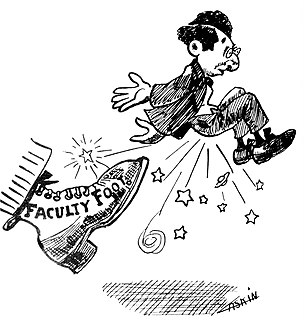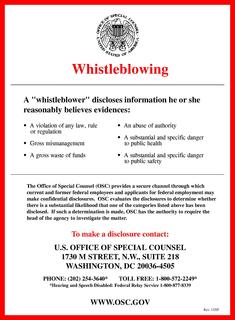In United States labor law, a hostile work environment exists when one's behavior within a workplace creates an environment that is difficult or uncomfortable for another person to work in, due to discrimination. Common complaints in sexual harassment lawsuits include fondling, suggestive remarks, sexually-suggestive photos displayed in the workplace, use of sexual language, or off-color jokes. Small matters, annoyances, and isolated incidents are usually not considered to be statutory violations of the discrimination laws. For a violation to impose liability, the conduct must create a work environment that would be intimidating, hostile, or offensive to a reasonable person. An employer can be held liable for failing to prevent these workplace conditions, unless it can prove that it attempted to prevent the harassment and that the employee failed to take advantage of existing harassment counter-measures or tools provided by the employer.
Sexual harassment is a type of harassment technique with explicit or implicit sexual overtones, including the unwelcome or inappropriate promise of rewards in exchange for sexual favors. Sexual harassment includes a range of actions from verbal transgressions to sexual abuse or assault. Harassment can occur in many different social settings such as the workplace, the home, school, churches, etc. Harassers or victims may be of any gender.
Oncale v. Sundowner Offshore Services, 523 U.S. 75 (1998), was a decision of the Supreme Court of the United States. The case arose out of a suit for sex discrimination by a male oil-rig worker, who claimed that he was repeatedly subjected to sexual harassment by his male co-workers with the acquiescence of his employer. The Court held that the protection of Title VII of the Civil Rights Act of 1964 against workplace discrimination "because of... sex" applied to harassment in the workplace between members of the same sex.

Dismissal is the termination of employment by an employer against the will of the employee. Though such a decision can be made by an employer for a variety of reasons, ranging from an economic downturn to performance-related problems on the part of the employee, being fired has a strong stigma in some cultures.
This is a list of topics on working time and conditions.

The California Department of Fair Employment and Housing is an agency of California state government charged with the protection of residents from employment, housing and public accommodation discrimination, and hate violence. It is the largest state civil rights agency in the United States. It also provides representation to the victims of hate crimes. Originally a division within the Department of Industrial Relations, DFEH became a separate department in 1980. DFEH has a director who is appointed by the governor of California and maintains a total of five offices and five educational clinics throughout the state. Today, it is considered part of the California Business, Consumer Services, and Housing Agency.
Employment discrimination is a form of discrimination based on race, gender, religion, national origin, physical or mental disability, age, sexual orientation, and gender identity by employers. Earnings differentials or occupational differentiation—where differences in pay come from differences in qualifications or responsibilities—should not be confused with employment discrimination. Discrimination can be intended and involve disparate treatment of a group or be unintended, yet create disparate impact for a group.
Burlington Northern & Santa Fe (BNSF) Railway Co. v. White, 548 U.S. 53 (2006), is a US labor law case of the United States Supreme Court on sexual harassment and retaliatory discrimination. It was a landmark case for retaliation claims. It set a precedent for claims which could be considered retaliatory under Title VII of the Civil Rights Act of 1964. In this case the standard for retaliation against a sexual harassment complainant was revised to include any adverse employment decision or treatment that would be likely to dissuade a "reasonable worker" from making or supporting a charge of discrimination.
Employment discrimination law in the United States derives from the common law, and is codified in numerous state and federal laws, particularly the Civil Rights Act of 1964, as well as in the ordinances of counties and municipalities. These laws prohibit discrimination based on certain characteristics or protected categories. The United States Constitution also prohibits discrimination by federal and state governments against their public employees. Discrimination in the private sector is not directly constrained by the Constitution, but has become subject to a growing body of federal and state law. Federal law prohibits discrimination in a number of areas, including recruiting, hiring, job evaluations, promotion policies, training, compensation and disciplinary action. State laws often extend protection to additional categories or employers.
The California Fair Employment and Housing Act of 1959, codified as Government Code §§12900 - 12996, is a California statute used to fight sexual harassment and other forms of unlawful discrimination in employment and housing, which was passed on September 18, 1959.
A workplace is a location where someone works for his or her employer, a place of employment. Such a place can range from a home office to a large office building or factory. For industrialized societies, the workplace is one of the most important social spaces other than the home, constituting "a central concept for several entities: the worker and his/her family, the employing organization, the customers of the organization, and the society as a whole". The development of new communication technologies have led to the development of the virtual workplace, a workplace that is not located in any one physical space.
Crawford v. Nashville, 555 U.S. 271 (2009), is a United States Supreme Court case in which the Court unanimously ruled that Title VII of the Civil Rights Act of 1964 protects an employee who opposes unlawful sexual harassment, but does not report the harassment him or herself.
Workplace aggression is a specific type of aggression which occurs in the workplace. Workplace aggression can include a wide range of behaviors, ranging from verbal acts to physical attacks.
Harassment covers a wide range of behaviors of an offensive nature. It is commonly understood as behavior that demeans, humiliates or embarrasses a person, and it is characteristically identified by its unlikelihood in terms of social and moral reasonableness. In the legal sense, these are behaviors that appear to be disturbing, upsetting or threatening. They evolve from discriminatory grounds, and have an effect of nullifying or impairing a person from benefiting their rights. When these behaviors become repetitive, they are defined as bullying. The continuity or repetitiveness and the aspect of distressing, alarming or threatening may distinguish it from insult.
Workplace deviance, in group psychology, may be described as the deliberate desire to cause harm to an organization – more specifically, a workplace. The concept has become an instrumental component in the field of organizational communication. More accurately, it can be seen as "voluntary behavior that violates institutionalized norms and in doing so threatens the well-being of the organization".
Workplace revenge refers to the general action of purposeful retaliation within the workplace in an attempt to seek justice. Acts of revenge in the workplace are viewed by the retaliator as a defensive act in response to the offender's unwarranted and unfair actions. When the offender makes the first move that is viewed by an affected colleague as unjust, the victim will often feel a need for retaliation.
Counterproductive work behavior (CWB) is employee behavior that goes against the legitimate interests of an organization. These behaviors can harm organizations or people in organizations including employees and clients, customers, or patients. It has been proposed that a person-by-environment interaction can be utilized to explain a variety of counterproductive behaviors. For instance, an employee who is high on trait anger is more likely to respond to a stressful incident at work with CWB.
Workplace harassment is the belittling or threatening behavior directed at an individual worker or a group of workers

A whistleblower is a person who exposes any kind of information or activity that is deemed illegal, unethical, or not correct within an organization that is either private or public. The Whistleblower Protection Act was made into federal law in the United States in 1989.
The law for workplace bullying is given below for each country in detail. Further European countries with concrete antibullying legislation are Belgium, France, and The Netherlands.


